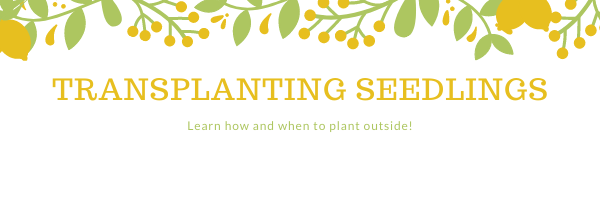When to plant seedlings outside?
Starting seeds and raising little baby plants inside takes a bit of attention and patience. For many fellow gardeners, the excitement of the coming spring is often too much! But if you start too early or plant outside too early, challenges will ensue. (I did that last year…)
Here are a few helpful suggestions to help you decide when and if your babies are ready to head to the great outdoors!
When to transplant outside: A general rule of thumb is that when a seedling has three to four true leaves, it's large enough to plant out in the garden (after it has been hardened-off).
Some plants, such as spinach, are cool-season crops, which means that they should be planted before outdoor temperatures get too warm. Others, like tomatoes and peppers, are warm-season crops and will be weakened by cooler temperatures. Make sure you look up what your plant wants.
Heat-loving plants shouldn’t be outside until nighttime temperatures remain consistently above 60°F.
When you think you’re ready to harden-off your plants, watch them for any signs of stress during that process. Be sure to keep soil moist during the hardening-off period.
Prep your garden area: loosen and amend soil, spread black plastic over the ground to raise soil temperature, and check soil moisture before you plant. Soil should be moist but not soaking wet. I also like to lay out a few layers of newspaper or contractors paper to help retain moisture and keep weeds down. Water deeply a day before working the soil. Soil that’s too dry will pull moisture out of plant roots and damage them.
After transplanting: Soak the soil around new seedlings immediately after transplanting in order to settle the roots, eliminate air pockets, and reduce the potential of transplant shock.
A few days after transplanting, give each seedling a cup of a starter fertilizer to ensure that phosphorus—which promotes strong root development—is available in the root zone of new transplants. Mix two tablespoons of a 15-30-15 starter fertilizer into a gallon of water (one tablespoon for vining crops such as melons and cucumbers).
If time and money permit, spread mulch to reduce moisture loss.
When in doubt, I consult the Farmer’s Almanac for answers and resources.
Their planting calendar is incredibly helpful if you’re just beginning or have questions about when to plant or transplant specific plants! Just type in your zip code and search for your plants to find the suggested dates to start inside, transplant seedlings or direct sow outdoors.
If possible, it’s also really helpful to keep track of when you start your seeds and when you transplant. That way, you have a better idea of your timing each year. I usually just put it right into my calendar to help my future self! If you’re looking for a little more support and local mentorship/networking with fellow gardeners, make sure to come check out our Free Seed + Plant Swap this weekend at Calvary Church in Irwin.
Happy Planting!
